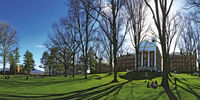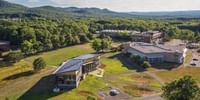The main educational goal of the program is to offer students a holistic understanding of acoustics as a discipline, by presenting all of its components, i.e. theory, practicum, and aesthetics, through a combination of survey and in-depth courses. Theoretical and applied theory elements of acoustics are introduced in courses such as Architectural Acoustics, Environmental Acoustics, Fundamentals of Vibration Analysis, Studies in Hearing, and Psychoacoustics, while courses like Acoustical Testing I, Acoustical Testing II, and Acoustical Modeling give students the opportunity to analyze and solve real-world problems, while developing a professional portfolio. Practical real-world exposure to the discipline is further emphasized in advanced courses such as Acoustics of Performance Spaces, and Engineered Acoustics, while the aesthetic element of the discipline presented in every class is furthered in courses such as Perception & Cognition of Sound, and Studies in Applied Acoustics.
In all, we have developed a curriculum that provides both the fundamental elements that any practitioner in acoustics should be intimately familiar with, as well as a series of courses that the student can choose from in order to match her/his specific educational and career goals. Students are also encouraged to become better practitioners in the field of acoustics by considering elective courses that truly reflect the foundation of an enlightened liberal arts education.
Students advance through the program in a cohort fashion, with a typical class of 12-15 students graduating in the spring semester. The cohort is expected to develop study groups, bring forth to the attention of the faculty common issues of interest to the students, and plan for and schedule research activities suitable for presentation in refereed conferences.
Although the Acoustics program aims at fostering a climate that develops team work, it also emphasizes individual attention to the students during all phases of their academic careers. Registration for most courses requires instructor permission, leading to regular one-on-one advising sessions between student and faculty members. In addition, office hours are held after every class and a wide range of individual tutoring options are available.








.png?tr=h-40,w-40,c-force)



